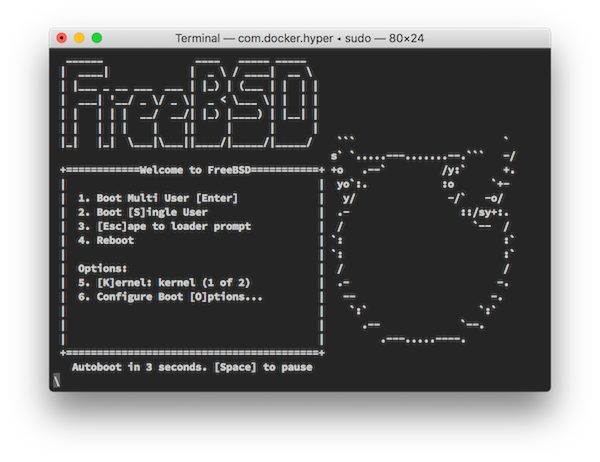FreeBSD on Hyperkit

Introduction
This document is a tutorial for FreeBSD installation using hyperkit.
Hyperkit Installation
Docker for mac
If you use the Docker for mac, then you've already have the hyperkit cli.
$ ls -og /usr/local/bin/hyperkit
lrwxr-xr-x 1 67 Apr 19 00:04 /usr/local/bin/hyperkit -> /Applications/Docker.app/Contents/Resources/bin/com.docker.hyperkit
Homebrew
If you are a homebrew user, you can also install it without the Docker for mac.
$ brew install hyperkit
FreeBSD on Hyperkit
Requirements
🧀 userboot.so
You need to get freebsd the FreeBSD user-mode bootloader.
$ curl -LO https://github.com/moby/hyperkit/raw/master/test/userboot.so
See also: userboot.txt
🍕 FreeBSD Insterller Image
Please download an installer image from https://www.freebsd.org/where.html
This document uses FreeBSD-11.2-RELEASE-amd64-bootonly.iso
☕️ Guest image file
Please create image file. This document uses 5 GB file.
$ mkfile 5g fbsd.img
🍗 Insterller script
hyperkitrun.sh
#!/usr/local/bin/bash
usage() { echo "Usage: $0 [-d FreeBSD.iso] [-i fbsd.img] [-l userboot.so] [-u UUID]" 1>&2; exit 1; }
while getopts d:i:l:u: OPT
do
case $OPT in
"d" ) DISC=$OPTARG ;;
"i" ) IMG=$OPTARG ;;
"l" ) USERBOOT=$OPTARG ;;
"u" ) UUID="-U $OPTARG" ;;
*) usage ;;
esac
done
shift `expr $OPTIND - 1`
if [ -z "$USERBOOT" ]; then
USERBOOT="userboot.so"
fi
if [ -z "$IMG" ]; then
IMG="fbsd.img"
fi
if [ "$DISC" ]; then
BOOTVOLUME="$DISC"
IMG_CD="-s 3:0,ahci-cd,$DISC"
else
BOOTVOLUME="$IMG"
fi
MEM="-m 2G"
SMP="-c 2"
PCI_DEV="-s 0:0,hostbridge -s 31,lpc"
NET="-s 2:0,virtio-net"
IMG_HDD="-s 4:0,virtio-blk,$IMG"
LPC_DEV="-l com1,stdio"
ACPI="-A"
HYPERKIT_BIN=`type -p hyperkit`
$HYPERKIT_BIN $ACPI $MEM $SMP $PCI_DEV $LPC_DEV $NET $IMG_CD $IMG_HDD $UUID -f fbsd,$USERBOOT,$BOOTVOLUME
FreeBSD Installation
$ sudo ./hyperkitrun.sh -d FreeBSD-11.2-RELEASE-amd64-bootonly.iso
Run VM
$ sudo ./hyperkitrun.sh
Network interface UUID
If you want the same IP address across VM reboots, generate UUID to assign to a particular VM.
$ python -c 'import uuid; print uuid.uuid4()'
0a02859a-a7cd-40cd-af18-ff2fa559a00a
$ sudo ./hyperkitrun.sh -u 0a02859a-a7cd-40cd-af18-ff2fa559a00a
See also: Apple's vmnet framework.
Conclusion
This document is a part of updates for this tutorial. mist64/xhyve has no updates frequently now. So I wrote this document using moby/hyperkit. The hyperkit is a core component of Docker For Mac. It has a xhyve/bhyve based hypervisor which is optimized for lightweight virtual machines and container deployment. This project managed 9 maintainers and 50 contributors (2018-10-01).
I will continue to update the tutorial document here. If there's something, please ask me @tanb.